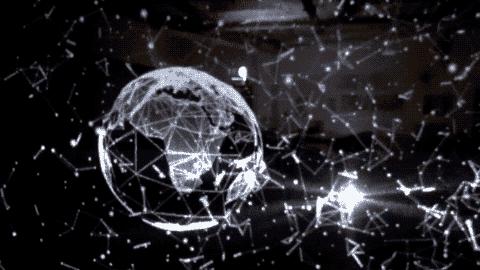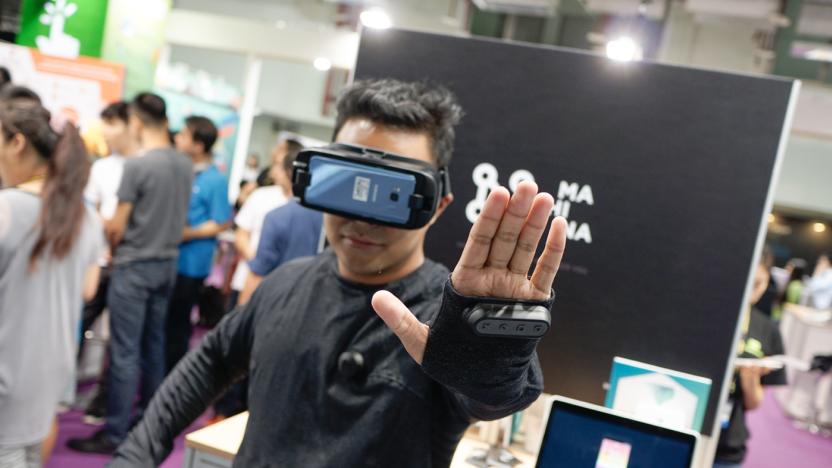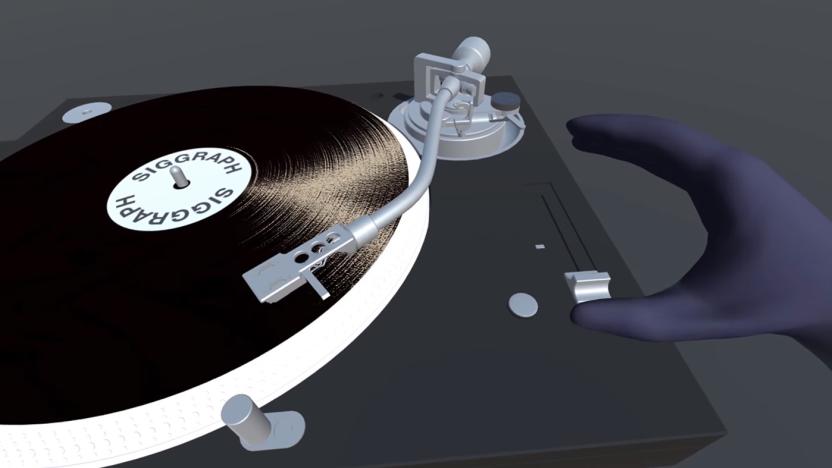MotionTracking
Latest

'Beat Saber' players were so fast that they broke Steam VR
Beat Saber, one of the coolest and most physical games available on VR, has some incredibly fast players. Valve recently announced that it updated Steam VR to "increase limits of what we thought was humanly possible for controller motion based on tracking data from Beat Saber experts." That's because some players are so good at the rhythm game that Steam VR couldn't even track them.

Touch-sensitive wall might let you control home devices in the future
Researchers at Carnegie Mellon University and Disney Research Pittsburgh think we can do more with our walls. In a research paper they're presenting this week at the ACM CHI Conference on Human Factors in Computing Systems, they present a way to turn all of the static walls that do little more than separate spaces into sensing, interactive, smart pieces of infrastructure. The result of their work is a prototype of Wall++, a wall that can track touch and gestures, sense nearby bodies and their positions as well as detect and locate active appliances.

You don't need a headset to see these 'no-lograms'
Genuine, Princess Leia-type color holograms are still pretty rare. Most of what we think of as holograms are actually Pepper's Ghost, Tupac-style illusions that trick your brain by using 2D images to simulate 3D. A French artist named Joanie Lemercier has taken the idea and added motion tracking to make it work even better. That way, the "no-logram" can change perspective as you move around it, fooling your brain into thinking the objects are truly 3D.

Fashion and tech collide in this VR-friendly connected shirt
Virtual reality is inescapable here at Computex: You're either stumbling into another Vive demo area or bumping into the occasional VR backpack. What's often missing is a sense of true immersion, and a startup called Machina is trying to fix that. Co-founder Antonio Perdigon was nice enough to let me don one of his unreleased "OBE" connected shirts here at the show, and after a little playtime, I think the team might be on to something.

This company can track motion with sound instead of light
When it comes to tracking physical objects in virtual spaces, pretty much every company is relying on light in some form. Oculus and HTC have their light mapping sensors, while Sony's PlayStation VR relies on infrared for its motion tracking camera. Hauoli, a young Austin-based startup demoing at SXSW, has something different in mind. It's developed a way to track virtual objects with sound. The solution is entirely software based and works with just about any speaker, so it also removes the need for expensive motion tracking hardware.

Microsoft's hand-tracking magic may lead to gamepad-free VR
The next Xbox One S console doesn't even have a Kinect port, showing that even Microsoft doesn't care about the depth sensor for gaming. However, it may yet make a comeback in VR. Microsoft researchers have made hand- and finger-tracking much more accurate using the Kinect, which may eventually make it a more attractive option than a controller for VR games. "We're getting to the point that the accuracy is such that the user can start to feel like the avatar hand is their real hand," says Microsoft UK researcher Jamie Shotton.

Google app contest winners show what Project Tango can do
Sure, Google and crew can put together some nice tech demos for Project Tango's advanced depth sensing and motion tracking, but what happens when everyday developers take a crack at it? You're about to find out. Google has announced the winners of its Project Tango App Contest, and most of them aren't what you'd expect given the technology. The overall winner is HeroicArcade's WeR Cubed Tango, a 3D puzzler that relies more on motion than the usual screen taps.

Razer's 3D-sensing camera brings motion tracking to your games
Razer has been big on immersive gaming as of late, and it's reinforcing that by unveiling a 3D-sensing camera at the Intel Developer Forum. The ominous-looking gadget uses Intel's RealSense to track your movement in games, whether you're sitting at a desktop or sporting a VR helmet (including Razer's own OSVR, naturally). For example, it can follow your head movements when you look to the side in a race car's cockpit. There aren't many more details to speak of just yet, but this hardware should arrive in the first quarter of 2016.

Nike's LED basketball court boosts training with motion tracking
Wearables have become popular among athletes for monitoring training progress, but on its recent Rise campaign stop in Shanghai, Nike took a different approach. Inside the so-call House of Mamba, NBA star Kobe Bryant hosted 30 young players from all over China who trained on a full-sized LED basketball court -- complete with projected graphics and motion tracking. The playing surface displayed reactive visuals based on players' movements for drills based on Bryant's own regimen. A dozen athletes will compete this weekend in Beijing with three winners moving on to the Nike World Basketball Festival in Barcelona next month. Curious to see how it works? Well, there's a pair of videos after the break that show just that.

Watch this: Human transforms its app data into striking activity maps
The folks behind Human know a thing or two about aesthetics, having crafted an activity-tracking app for iOS that's quite lovely. The mobile software keeps tabs on walking, running, biking and vehicular motion with goal of racking up at least 30 minutes of physical activity per day. Now, the outfit has taken user data from 30 of the largest cities in the world and constructed visualizations for each locale. Maps for all three of the aforementioned endeavors are included, broken down by activity for further analysis. Don't take our word for it though, watch the cartographic motion take place for yourself after the break.

HP's Leap Motion keyboard to be sold separately for $99
The Leap Motion controller is currently present in three forms: a $74.99 standalone dongle, inside the special edition HP Envy 17 laptop and inside an HP keyboard. The dongle -- with almost half a million units sold since launch -- and the keyboard are obviously the only ways to add this hand motion sensor externally, but the latter option was limited to select HP computers to begin with. Well, not any more. At Computex, Leap Motion told Engadget that as of this month, you'll be able to purchase said keyboard for about $99, and it'll work on any Windows 7 or Windows 8 PC as long as you have the software installed -- be it the current version or the free V2 update with skeletal tracking coming this summer.

Computer trickery makes these shadows 'dance'
You know how to turn crooked vases into an interesting art installation that remind us of Beauty and the Beast's singing pots and candlesticks? We'd like to say magic, but since we don't live in a Disney movie, the right answer is motion tracking and real-time 3D rendering. The installation's creators, artist Laurent Craste and digital agency Dpt., used a hidden projector to make the vases' shadows dance whenever a viewer swings the lamp above them. Their movements even depend on the lamp's swing, so side-to-side swinging triggers the same animation, while a more circular one also shows the lamp's shadows going in circles. Sadly, you can't see this in person anymore (it was displayed at a festival in Montreal in May), but you can watch the video after the break.

Scientists use lasers to make fruit flies do a song and dance
What with their simple genetics and ultra-brief lifespan, poor fruit flies are the go-to insect for mad scientists. Researchers have discovered a new way to make their lives miserable with a mind-altering project called FlyMAD (not kidding). There's even an overly-elaborate plan: motion tracking cameras guide a specially-tuned laser to zap the insects like a tiny missile system. That activates light and heat neurons in their brains, triggering singing and dancing that seduces no actual female Drosophila. The scientists, however, were well pleased, and think they can further manipulate their subjects by perfecting the technique -- which we're sure has infinite real-world application.

New NBA stats deal will put motion tracking cameras in every arena
The NBA faces a big challenge now that it offers all its player statistics to the public -- how does it generate stats that hold the interest of basketball fans? The league's solution is a multi-year agreement to use Stats LLC's SportVU motion tracking system in every arena (15 teams had already implemented the technology on their own). As of the 2013-14 season, every NBA arena will have a six-camera setup that creates a steady stream of player data based on ball possession, distance, proximity and speed. The NBA's website, NBA Game Time and NBA TV will all use the information to expand game stats beyond what we see today with heat maps and specific details on each possession. There's no telling how useful that extra knowledge will be, but we won't be shocked if it helps settle a few sports bar arguments. [Image credit: Rondo Estrello, Rondostar.com / Flickr]

University of Tokyo's fast-tracking camera system could revolutionize sports coverage (video)
Researchers at the University of Tokyo's Ishikawa Oku Lab have been hard at work on a camera system that can track fast moving objects incredibly well, and the technology may change the way sports like baseball and soccer are televised. Recently, the team building the system has entered the next phase of testing: taking it outside, to see if will perform as well as it has in a lab setting. If all goes according to plan, they expect it'll be ready for broadcast use in roughly two years. Demos of the tech are pretty impressive, as you can see in the video below showing the (warning: not recommended watching for those easily prone to motion sickness). To get the ping-pong ball-centric shots, the system uses a group of lenses and two small mirrors that pan, tilt and move so the camera itself doesn't have to. The mirrors rely on a speedy image tracking system that follows movement, rather than predicting it. Swapping the camera out for a projector also has some interesting applications -- it can paint digital pictures on whatever its tracking. Sounds like the perfect gadget for folks who wish their table tennis balls looked like emoji.

Microsoft: next-gen Kinect sensor for Windows to launch in 2014
Microsoft already gave us a look at its next-gen Kinect alongside the Xbox One, but today the company circled back to announce an update to the Windows version of its sensor. Don't get too excited yet, though: the update won't debut until 2014. Still, Redmond has shared details about some of the enhancements it says will "revolutionize computing experiences," such as a higher-definition camera, expanded field of view and improved motion tracking -- essentially the same improvements we'll see on the new Kinect for the Xbox One. Microsoft says developers will learn more about the updated hardware and SDK at the Build 2013 conference in June, so stay tuned.

Eyes-on: MIT Media Lab's Smarter Objects can map a user interface onto... anything (video)
While patrolling the halls of the CHI 2013 Human Factors in Computing conference in Paris, we spied a research project from MIT's Media Lab called "Smarter Objects" that turns Minority Report tech on its head. The researchers figured out a way to map software functionality onto tangible objects like a radio, light switch or door lock through an iPad interface and a simple processor / WiFi transceiver in the object. Researcher Valentin Huen explains that "graphical user interfaces are perfect for modifying systems," but operating them on a day-to-day basis is much easier using tangible objects. To that end, the team developed an iPad app that uses motion tracking technology to "map" a user interface onto different parts of an object. The example we saw was a simple radio with a a pair of dials and a speaker, and when the iPad's camera was pointed at it, a circular interface along with a menu system popped up that cannily tracked the radio. From there, Huen mapped various songs onto different positions of the knob, allowing him to control his playlist by moving it -- a simple, manual interface for selecting music. He was even able to activate a second speaker by drawing a line to it, then "cutting" the line to shut it off. We're not sure when, or if, this kind of tech will ever make it into your house, but the demo we saw (see the pair of videos after the break) seemed impressively ready to go.

Sony reveals how the PlayStation 4 Eye works
Sony's Shuhei Yoshida has dished the dirt on how the company's latest camera accessory will work. The PlayStation 4 Eye comes with a pair of 1,280 x 800 cameras, four microphones and an 85-degree field of view. The two lenses are designed to be used in a variety of ways, including triangulating the 3D space, gesture recognition, Kinect-style body tracking, and in conjunction with accessories like the Wonderbook or DualShock 4 controller. "It's not just a way to identify your player number, it also works like a PS Move," Yoshida said of the new DualShock's light bar. "It's an extension of the PS Move technology that we incorporated into the DualShock so that the camera can see where it is." The Sony Studios chief used a PS Eye-style AR game as an example, saying that with the original camera, one lens had to do everything. With the new unit, one camera will concentrate on capturing the action and ensuring good picture quality, while the other is dedicated to motion tracking. Another reason that the Move functionality was incorporated into the DualShock is to enable the console know where you're sitting in relation to the TV (and your on-screen character). The company is also aiming to enable users to take 3D pictures and video and store it on the console. As for the microphones in the new Eye and how that'll impact interaction with the PlayStation 4 on a system level, Yoshida wasn't giving up any details. Though he said it'll be incorporated into games (a la Kinect voice commands on Xbox 360 games), he wouldn't give up whether you could use your voice to control the PlayStation 4 on a system level. Ben Gilbert contributed to this report.

Leap Motion used for legitimate air drumming, authentic instrument control
Hacking Kinect might get you access to an audible air guitar, but Stephane Berscot can do you one better -- tweaking the pitch of a tangible axe via Leap Motion's virtual work space. Berscot configured a Leap tweak his guitar's pitch based on the instrument's position over the device. That's not all, either, the makeshift MIDI controller also functions as a keyboard equalizer and a set of functional air drums. Combining all three tricks together scored Berscot a pretty mean demo track, but it's apparently a lot harder than it looks. "It wasn't easy to play drums with it," he said, explaining how he had to detect beats based tracking the upward and downward velocity of the drumstick. "My method is pretty basic and still needs some work." Even so, the demo definitely shows the device's potential. Skip on past the break to see Berscot kick out the jams.

Extreme Reality's Extreme Motion uses 2D webcams for 3D motion games, we go hands-on (update: video)
Extreme Reality's technology revolves around gestures, and its latest effort is to bring that movement to the masses: its Extreme Motion developer kit turns just about any off-the-shelf webcam or built-in camera on common platforms, including Android, iOS and Windows, into an almost Kinect-like system capable of tracking 3D motion. Despite missing depth cameras or other additional sensors, it's theoretically quite accurate -- the software tracks joints across the body in every frame, although it's not quite so sensitive as to track fingers. This author had the chance to make a fool of himself in front of a laptop's camera to see how well Extreme Motion works. In short, reasonably well: while it wasn't in perfect sync, it recognized with less-than-elegant moves in a Dance Central-style demo title and flagged whether a shimmy was right on target or evidence of two left feet. Of course, this experiment was conducted in a brightly-lit hotel ballroom, where body detection is ideal, so take the experiment with a grain of salt. It's still adept enough that the developers who will have access to the (currently free) toolkit can produce motion games we'd be sincerely interested in playing. Update: Want to see Extreme Motion in action? If you're into seeing an Engadget editor expressing himself through the art of dance, a video demo awaits after the break. Michael Gorman contributed to this report.











